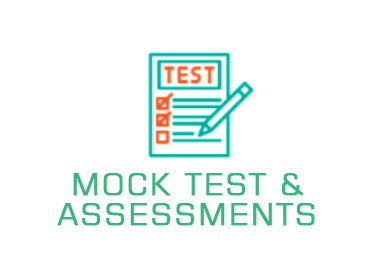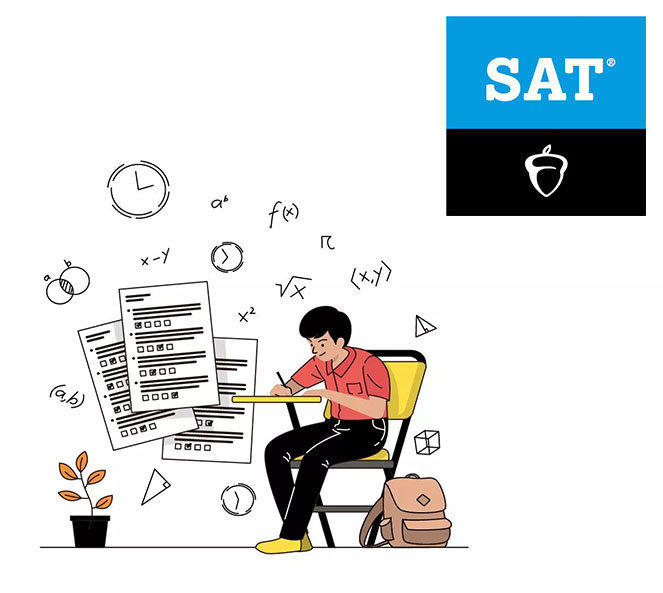The SAT is a standardized examination conducted by the College Board, and students applying for admission to undergraduate schools must take it. The Scholastic Assessment Test, previously known as the Scholastic Aptitude Test.
The SAT is a standardized exam required by most universities in The U.S.A, Canada, Europe and the Middle East to assess a candidate's profile. The candidate's SAT score is used to evaluate their academic potential in comparison with the rest of the program's applicant pool. The test consists of 2 core sections, Verbal and Math, which are individually scored on a range of 200-800 and added to form the overall score. The SAT exam was developed to assess the applicants verbal, mathematics & written skills. Applicants who wish to pursue undergraduate courses, especially in Canada & US are obliged to take the SAT exam.
Our SAT tutors undergo the most rigorous SAT training regimen in the industry to learn our exclusive SAT test preparation methods.
We know what schools look for in applicants. Our admissions experts will help you craft a plan that helps get you into your top-choice schools.
We've built proven SAT test strategies and comprehensive content to maximize your SAT Scores.




For candidates applying for the SAT, the College Board, that is the SAT’s governing body, has not set any clear SAT eligibility rules.
Interested to join Intensive SAT Coaching Classes?
For information on enrollment please Call: +971 506016017.
To evaluate the necessary knowledge to access & solve problems, SAT requires sections such as critical reading, mathematics & writing.
Candidates need to take the SAT II exam at individual universities.
It is a three-hour multiple-choice examination used to test the reasoning ability verbally and mathematically. The SAT-I scoring is necessary for most of the university.
It is a multiple-choice test for one hour, that used to evaluate the knowledge of specific subjects and the ability to utilize that understanding. Together with SAT-I, a few universities require this score also.

| Points | Minutes | Questions |
|---|---|---|
| 200-800 | 60 | 80 (Multiple Choice) |
| Sl | Units | Chapters | Approximate % |
|---|---|---|---|
1 |
Number and Operations |
| 10% – 14% |
2 |
Algebra and Functions |
| 38% – 42% |
3 |
Geometry and Measurement |
| 38% – 42% |
4 |
Plane Euclidean/Measurement |
| 18% – 22% |
5 |
Coordinate |
| 8% – 12% |
6 |
Three-dimensional |
| 4% – 6% |
7 |
Trigonometry |
| 6% – 8% |
8 |
Data Analysis, Statistics and Probability |
| 8% – 12% |
| Points | Minutes | Questions |
|---|---|---|
| 200-800 | 60 | 80 (Multiple Choice) |
| Sl | Units | Chapters | Approximate % |
|---|---|---|---|
1 |
Number and Operations |
| 10% – 14% |
2 |
Algebra and Functions |
| 48% – 52% |
3 |
Geometry and Measurement |
| 28% – 32% |
4 |
Plane Euclidean/Measurement |
| - |
5 |
Coordinate |
| 10% – 14% |
6 |
Three-dimensional |
| 4% – 6% |
7 |
Trigonometry |
| 12% – 16% |
8 |
Data Analysis, Statistics and Probability |
| 8% – 12% |
| Points | Minutes | Questions |
|---|---|---|
| 200-800 | 60 | 80 (Multiple Choice) |
| Sl | Units | Chapters | Approx % |
|---|---|---|---|
1 |
Mechanics |
| 36%–42% |
2 |
Electricity and Magnetism |
| 18%–24% |
3 |
Waves and Optics |
| 15%–19% |
4 |
Heat and Thermodynamics |
| 6%–11% |
5 |
Heat and Thermodynamics |
| 6%–11% |
6 |
Modern Physics |
| 6%–11% |
7 |
Miscellaneous |
| 4%–9% |
| Points | Minutes | Questions |
|---|---|---|
| 200-800 | 60 | 50 (Multiple Choice) |
| Sl | Units | Chapters | Approximate % |
|---|---|---|---|
1 |
Structure of Matter |
| 25% |
2 |
States of Matter |
| 16% |
3 |
Reaction Types |
| 14% |
4 |
Stoichiometry |
| 14% |
5 |
Equilibrium and Reaction Rates |
| 5% |
6 |
Thermochemistry |
| 6% |
7 |
Descriptive Chemistry |
| 12% |
8 |
Laboratory |
| 8% |
| Points | Minutes | Questions |
|---|---|---|
| 200-800 | 60 | 80 (Multiple Choice) |
| Sl | Units | Chapters | Approximate % |
|---|---|---|---|
1 |
Cell and Molecular Biology |
| 12% (E)
25% (M) |
2 |
Ecology |
| 25% (E)
12% (M) |
3 |
Genetics |
| 12% (E)
25% (M) |
4 |
Organismal Biology |
| 25% (E)
25% (M) |
5 |
Evolution and Diversity |
| 25% (E)
12% (M) |